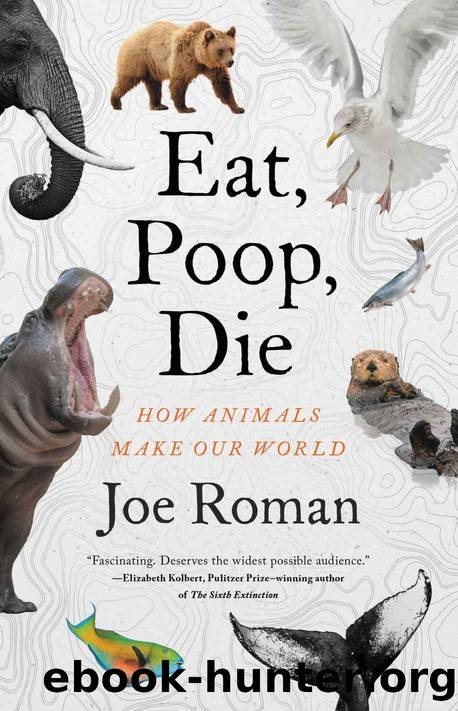Eat, Poop, Die: How Animals Make Our World by Joe Roman Phd

Author:Joe Roman Phd [Roman, Joe Phd]
Language: eng
Format: epub
ISBN: 9780316372923
Barnesnoble:
Publisher: Little, Brown and Company
Published: 2023-11-07T05:00:00+00:00
CUSHMAN SETS THE start of the Anthropocene at 1830, with the first shipment of nitrate fertilizer, soon followed by guano from South America to England. Guano was pickaxed out of the ground, loaded onto carts, and lowered to waiting vessels. As the international guano trade grew, tens of thousands of laborers were brought over from China to work beside local convicts and debtors, many in conditions of slavery. American, British, and German ships soon crowded the Peruvian coastline, eager to fill their holds with the cargo.
Guano was as essential to the Industrial Revolution as fossil fuel, Cushman argues, the European discovery marking a pivotal moment in human history. As they uncovered its value, Humboldtâs colleagues considered the export of guano akin to a moral mission; the spread of nitrogen and phosphorus was good for all people. Soil enriched with guano kick-started input-intensive farming, increasing the productivity of crop- and pasturelands, allowing urban populations to grow and thrive. A common dictum in the nineteenth century was âMake two blades of grass grow where one grew before.â Guano helped make that possible. The fertilizer reached Europe at the end of one long era of human history, a time of stability, small towns, and subsistence farming, and helped galvanize anotherâan era soon dominated by machine production, the steam engine, and agriculture produced for urban markets.
The nineteenth century was the age of guano, and the search for this powerful fertilizer drove global commerce, starting on the ancient coasts of Peru and soon encompassing some of the remotest islands in the world. The significance of this trade is almost impossible to overstate. In 1841, Britain imported about two tons of Peruvian guano. Four years later, it imported nearly 220,000 tons. Moving nutrients continues to dominate food production today. Fertilizer from guano altered the nitrogen cycle in the Northern Hemisphere and caused a grasslands revolution in the outposts of Australia and New Zealand. Southern pastures became more fertile, and the lamb and beef raised on bird dung were exported to Europe, the United States, and the Middle East. âPeruvian guano mainly served northern consumers of meat and sugar,â Cushman wrote; it wasnât fighting world hunger.
Download
This site does not store any files on its server. We only index and link to content provided by other sites. Please contact the content providers to delete copyright contents if any and email us, we'll remove relevant links or contents immediately.
| Anatomy | Animals |
| Bacteriology | Biochemistry |
| Bioelectricity | Bioinformatics |
| Biology | Biophysics |
| Biotechnology | Botany |
| Ecology | Genetics |
| Paleontology | Plants |
| Taxonomic Classification | Zoology |
Sapiens: A Brief History of Humankind by Yuval Noah Harari(13078)
The Tidewater Tales by John Barth(12039)
Do No Harm Stories of Life, Death and Brain Surgery by Henry Marsh(6343)
Mastermind: How to Think Like Sherlock Holmes by Maria Konnikova(6251)
The Thirst by Nesbo Jo(5795)
Why We Sleep: Unlocking the Power of Sleep and Dreams by Matthew Walker(5657)
Sapiens by Yuval Noah Harari(4553)
Life 3.0: Being Human in the Age of Artificial Intelligence by Tegmark Max(4520)
The Longevity Diet by Valter Longo(4454)
The Rules Do Not Apply by Ariel Levy(3914)
The Immortal Life of Henrietta Lacks by Rebecca Skloot(3833)
The Body: A Guide for Occupants by Bill Bryson(3816)
Why We Sleep by Matthew Walker(3781)
Animal Frequency by Melissa Alvarez(3762)
Yoga Anatomy by Kaminoff Leslie(3711)
Barron's AP Biology by Goldberg M.S. Deborah T(3636)
The Hacking of the American Mind by Robert H. Lustig(3588)
All Creatures Great and Small by James Herriot(3527)
Yoga Anatomy by Leslie Kaminoff & Amy Matthews(3405)
